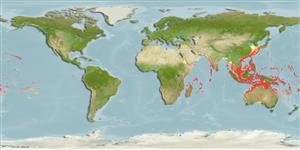Actinopterygii (ray-finned fishes) >
Perciformes (Perch-likes) >
Lutjanidae (Snappers) > Lutjaninae
Etymology: Lutjanus: Malay, ikan lutjan, name of a fish.
Environment / Climate / Range
Ecology
Marine; reef-associated; depth range 1 - 150 m (Ref. 9710). Tropical, preferred 28°C (Ref. 107945); 35°N - 33°S, 31°E - 134°W (Ref. 55)
Indo-Pacific: Red Sea and East Africa to the Line and Society islands, north to southern Japan, south to Australia.
Length at first maturity / Size / Weight / Age
Maturity: Lm 21.5 range ? - ? cm
Max length : 50.0 cm TL male/unsexed; (Ref. 55); common length : 45.0 cm TL male/unsexed; (Ref. 5450); max. reported age: 18 years (Ref. 2293)
Adults mainly inhabit coral reefs, sometimes forming large aggregations, which are mostly stationary during the day. Juveniles occur in seagrass beds, also in mixed sand and coral habitats of shallow sheltered reefs (Ref. 1602). Sub-adults commonly form very large schools that are stationary or drift slowly along slopes during the day. Large individuals along coastal slopes at moderate depths (Ref. 48635). Benthopelagic (Ref. 58302). Feed on fishes, and a variety of invertebrates including shrimps, crabs, lobsters, stomatopods, cephalopods, echinoderms and ophiuroids (Ref. 55).
Off East Africa spawning occurs mainly during spring and summer.
Allen, G.R., 1985. FAO Species Catalogue. Vol. 6. Snappers of the world. An annotated and illustrated catalogue of lutjanid species known to date. FAO Fish. Synop. 125(6):208 p. Rome: FAO. (Ref. 55)
IUCN Red List Status (Ref. 115185)
CITES (Ref. 94142)
Not Evaluated
Threat to humans
Reports of ciguatera poisoning (Ref. 9710)
Human uses
Fisheries: commercial; gamefish: yes; aquarium: public aquariums
More information
ReferencesAquacultureAquaculture profileStrainsGeneticsAllele frequenciesHeritabilityDiseasesProcessingMass conversion
Tools
Can't connect to MySQL database fbquizv2. Errorcode: Too many connections
